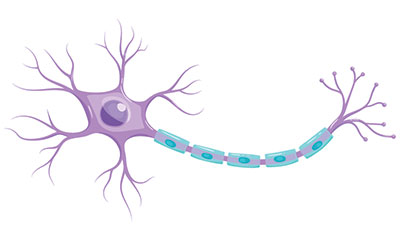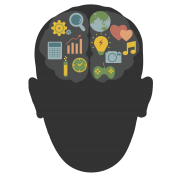Neuroscience Simplified: Exploring 4 Key Brain Science Concepts

You don’t need to be a neuroscientist to grasp the basics of how the brain works. Sure, your body’s command center is complex—a lot happens inside your skull. But a handful of key concepts can help you establish a working knowledge of the fundamentals of brain power.
Start flexing your mind muscles and learn about four basic brain-science concepts.
The Mechanics of Brain Power
Your brain is packed with nearly 100 billion (100,000,000,000) neurons. Each links with other neurons to create networks that, in total, boost trillions of connections. This massive, complex web makes your brain the powerful central computer it is. And that’s how it’s possible for the brain to handle all the world throws at it—thinking, reacting, recalling, and controlling every aspect of your life.
But how does it work? The complexity makes it hard to understand. But knowing the parts and spinning a simple metaphor can help unravel the mysteries of brain mechanics.
The neurons in your brain look like a tree stump, with a main body (called the soma) and roots reaching out all around. A tree’s roots are for collection—spidering into the soil to bring in nutrients and water. The roots coming off a neuron body need to collect and communicate.
That’s why neurons have two types of extensions—dendrites and an axon. Dendrites collect information and take in signals from other neurons. And the axon transmits messages using specialized chemicals called neurotransmitters.
Synapses are the interfaces where messages are transferred. These connections between the axon terminals of one neuron and the dendrites of another make communication in the brain possible.
Each of your neurons is like a tiny TV news network. The reporters and producers are the dendrites reaching out to sources, collecting facts, and gathering the news. The anchor who broadcasts the news is the axon, passing on messages from the news network (or, in this example, the neuron).
Together, this connected community of information sharers keeps your brain up to date and communicating fluidly.
Exploring Your Ability to Adapt with Neuroplasticity
Your brain takes in so much data every minute of every day. Your environment, emotions, and other circumstances are also constantly changing. With all the input and perpetual transition, your brain has to adapt.
Neuroplasticity describes your brain’s incredible flexibility.
This is much more than the ability to change your mind about a topic. Neuroplasticity is the physical adaptations your brain makes by rewiring neural connections and networks. Using neuroplasticity, your powerful brain can switch the area where certain tasks are performed if the need arises. (Be careful not to confuse neuroplasticity with neurogenesis, which is the process of creating new neurons.)
Many circumstances have been shown to prompt the brain reorganization done through neuroplasticity. Physical injury, emotional trauma, and emotional stress all initiate change. More positive situations, like learning and improving your environment, can also stimulate neuroplasticity.
You know your brain is going to adapt. What you can do is help guide that rewiring through positive habits.
Executive Functions Help You Grow Up Mentally
Your ability to conquer your daily life has a lot to do with a collection of cognitive skills called your executive functions. And you learned and earned these skills—because you aren’t born with fully developed executive functions.
They include:
- Shifting attention around
- Controlling your impulses
- Regulating behavior
- Considering consequences before acting
- Remaining focused
Executive functions also help you toss around abstractions until you eventually create concrete conclusions. And they encompass your working memory, mental flexibility, and aspects of your creative problem-solving abilities.
Even if this concept is new to you, it’s not to your brain. You’ve used your executive functions to make your way through school. They’ve helped you achieve physical health goals. Executive functions even aided with managing emotions during tricky or rough times. And now you know what to call them.
Working Memory vs. Short-Term Memory
Defining memory seems simple. It’s what you can remember, right? Your brain’s storage capacity. What you can recall when you need to.
There’s a little more to memory than that. It starts with defining and differentiating the main types of memory.
Long-term memory is pretty self-explanatory, and easily separated from short-term and working memory. If it’s stored for more than a minute, it likely falls under long-term memory. But comparing working and short-term memory is a little bit more involved.
Short-term memory is the ability to remember small amounts of information for under a minute. Your ability to keep a number in your mind for long enough to write it down is an example of short-term memory. But you forget a lot of what’s stored in short-term memory.
Working memory has limited space, but it’s a conduit for moving information from the senses to short- and long-term memory. And it also shuffles longer stored items to the front of your attention and mixes them with current stimuli to help you accomplish tasks in front of you.
Cooking your favorite meal provides an example of working memory. You’re pulling the ingredients, proportions, and timing from your long-term memory. Your working memory helps you complete the dish by mixing sights, sounds, and smells with the stored data in the recipe. That helps your meal come out right—without extra or incorrect ingredients and cooked properly.
So, the main different between working and short-term memory? Working memory allows you to manipulate memories and stimuli. Short-term memory is just temporary storage.
What’s Next for Your Neuroscience Journey?
This is just the tip of the brain-science iceberg. But now that you know more about these topics, you can expand your learning with some interesting facts about your brain. Or maybe it’s time for you to take action. Start feeding your brain the right foods, and establish a baseline to aid in tracking the progress of your cognitive skills.
No matter where this rabbit hole leads, you understand how your brain will adapt, the way neurons will facilitate the communication of new information, and how facts will be stored in your memory.
References
https://www.aans.org/en/Patients/Neurosurgical-Conditions-and-Treatments/Anatomy-of-the-Brain
https://www.verywellmind.com/what-is-cognition-2794982
https://www.dana.org/explore-neuroscience/brain-basics/key-brain-terms-glossary/
https://www.ninds.nih.gov/Disorders/Patient-Caregiver-Education/Know-Your-Brain
https://learn.genetics.utah.edu/content/memory/types/
https://www.ncbi.nlm.nih.gov/pmc/articles/PMC2657600/
https://www.ncbi.nlm.nih.gov/pmc/articles/PMC4084861/
https://developingchild.harvard.edu/science/key-concepts/executive-function/
https://www.dana.org/article/how-does-the-brain-work/
https://www.ninds.nih.gov/Disorders/Patient-Caregiver-Education/Life-and-Death-Neuron














